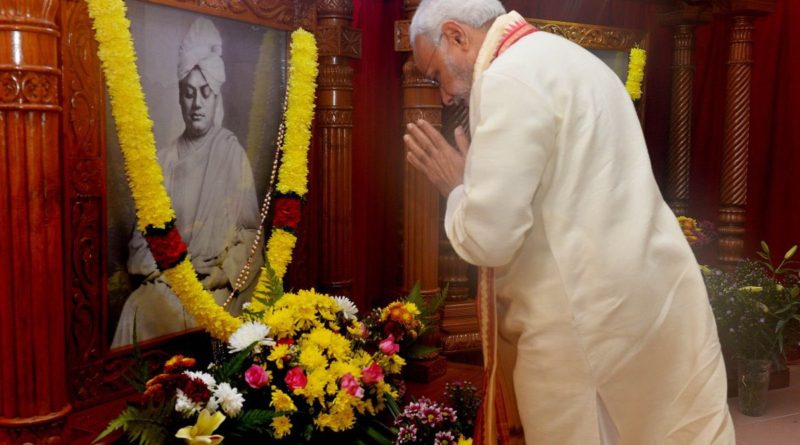SWAMI VIVEKANANDA’S DAYS OF PEACE IN UTTARAKHAND
We offer salutations to the great Swami Vivekananda
Narendra Modi @narendramodi 8h8 hours ago
We offer salutations to the great Swami Vivekananda & remember his powerful thoughts & ideals that continue shaping the minds of generations
Swami Vivekananda, who passed away on July 4, 1902, at the young age of 39, at Belur Math near Kolkata, spent a very happy and peaceful time in the hills and dales of the Uttarakhand region to which he was emotionally attached.
He has a very special connection with Almora in the Kumaon region of Uttarakhand which also had a special place in the lives of other great personalities like Gurudev Rabindranath Tagore, Mahatma Gandhi, Sri Aurobindo, Pandit Jawahar Lal Nehru and Uday Shankar.
Swami Vivekananda set up the Advaita Ashram in Mayavati in Kumaon. On May 1, 1897 Vivekananda founded the “Ramakrishna Mathh” in Calcutta.This was the organ for propagating religion and “Ramakrishna Mission” was the organ for social service. This was the beginning of an organised socio-religious movement to help the masses through educational, cultural, medical and relief work.
Swamiji had always been attracted by the Himalayas. During his tour of the Swiss Alps the idea to found an Ashram in similar conditions in India took shape. In Almora, he inspired Captain Sevier and Mrs. Sevier along with Swami Swarupananda, his disciple, to commence looking for a place to house an Ashram. They found it in Mayavati, 6,400 ft. above sea level, surrounded by mountains on three sides, one side opening to a breathtaking view of the snow-capped Himalayan range. The Advaita Ashrama,also called Mayavati Ashram, was inaugurated in March 1899. Swamiji paid the Ashram a visit in January 1901 and stayed for a fortnight.
Swami Vivekananda made several visits to Almora. After the passing away of his Guru, Sri Ramakrishna, Swami Vivekenanda travelled throughout India teaching Vedanta, and in 1890 he had walked from Nainital to Almora. He spent several days meditating in a cave on a hill close to the Kasaar Devi temple. Following the demise of his mentor Swami Ramkrishna, the young Narendra (later to be known as Swami Vivekananda), while scaling the wilderness of Kumaon, is believed to have said that he had “seen the macrocosm in a microcosm.”
Located 22 km from Champawat amid an old tea estate, Mayawati shot into prominence after the Advaita Ashram was established here. The ashram attracts spiritualists from India and abroad.
It has a press of its own and the first editions of Swami Vivekananda’s works were published from Mayavati, besides Prabuddha Bharata, the monthly journal. A good library stocked with excellent books naturally grew. The ashram also runs the Mayavati Charitable Hospital which serves free of charge nearly 1,400 villages in this remote and backward region of the Himalayas. There is also a library and a small museum at Mayawati.
On his arrival at Almora, Swami Vivekananda received an Address of Welcome from the citizens of Almora, to which he made the following reply: “This is the land of dreams of our forefathers, in which was born Pârvati, the Mother of India. This is the holy land where every ardent soul in India wants to come at the end of its life, and to close the last chapter of its mortal career.
This is the land which, since my very childhood, I have been dreaming of passing my life in, and as all of you are aware, I have attempted again and again to live here; and although the time was not ripe, and I had work to do and was whirled outside of this holy place, yet it is the hope of my life to end my days somewhere in this Father of Mountains where Rishis lived, where philosophy was born … I sincerely pray and hope, and almost believe, that my last days will be spent here, of all places on earth. Inhabitants of this holy land, accept my gratitude for the kind praise that has fallen from you for my little work in the West….
As peak after peak of this Father of Mountains began to appear before my sight, all the propensities to work, that ferment that had been going on in my brain for years, seemed to quiet down, and instead of talking about what had been done and what was going to be done, the mind reverted to that one theme the Himalayas always teach us, that one theme which reverberates in the very atmosphere of the place — renunciation! The Himalayas stand for that renunciation.” (Extract from: The Complete Works of Swami Vivekananda/Volume 3/Lectures from Colombo to Almora ).
This is the land of dreams of our forefathers, in which was born Pârvati, the Mother of India. This is the holy land where every ardent soul in India wants to come at the end of its life, and to close the last chapter of its mortal career. On the tops of the mountains of this blessed land, in the depths of its caves, on the banks of its rushing torrents, have been thought out the most wonderful thoughts, a little bit of which has drawn so much admiration even from foreigners, and which have been pronounced by the most competent of judges to be incomparable. This is the land which, since my very childhood, I have been dreaming of passing my life in, and as all of you are aware, I have attempted again and again to live here; and although the time was not ripe, and I had work to do and was whirled outside of this holy place, yet it is the hope of my life to end my days somewhere in this Father of Mountains where Rishis lived, where philosophy was born. Perhaps, my friends, I shall not be able to do it, in the way that I had planned before — how I wish that silence, that unknownness would be given to me — yet I sincerely pray and hope, and almost believe, that my last days will be spent here, of all places on earth.
Inhabitants of this holy land, accept my gratitude for the kind praise that has fallen from you for my little work in the West. But at the same time, my mind does not want to speak of that, either in the East or in the West. As peak after peak of this Father of Mountains began to appear before my sight, all the propensities to work, that ferment that had been going on in my brain for years, seemed to quiet down, and instead of talking about what had been done and what was going to be done, the mind reverted to that one eternal theme which the Himalayas always teach us, that one theme which is reverberating in the very atmosphere of the place, the one theme the murmur of which I hear even now in the rushing whirl*pools of its rivers — renunciation!
— “Everything in this life is fraught with fear. It is renunciation alone that makes one fearless.” Yes, this is the land of renunciation.
The time will not permit me, and the circumstances are not fitting, to speak to you fully. I shall have to conclude, therefore, by pointing out to you that the Himalayas stand for that renunciation, and the grand lesson we shall ever teach to humanity will be renunciation. As our forefathers used to be attracted towards it in the latter days of their lives, so strong souls from all quarters of this earth, in time to come, will be attracted to this Father of Mountains, when all this fight between sects and all those differences in dogmas will not be remembered any more, and quarrels between your religion and my religion will have vanished altogether, when mankind will understand that there is but one eternal religion, and that is the perception of the divine within, and the rest is mere froth: such ardent souls will come here knowing that the world is but vanity of vanities, knowing that everything is useless except the worship of the Lord and the Lord alone.
Friends, you have been very kind to allude to an idea of mine, which is to start a centre in the Himalayas, and perhaps I have sufficiently explained why it should be so, why, above all others, this is the spot which I want to select as one of the great centres to teach this universal religion. These mountains are associated with the best memories of our race; if these Himalayas are taken away from the history of religious India, there will be very little left behind. Here, therefore, must be one of those centres, not merely of activity, but more of calmness, of meditation, and of peace; and I hope some day to realise it. I hope also to meet you at other times and have better opportunities of talking to you. For the present, let me thank you again for all the kindness that has been shown to me, and let me take it as not only kindness shown to me in person, but as to one who represents our religion. May it never leave our hearts! May we always remain as pure as we are at the present moment, and as enthusiastic for spirituality as we are just now!
www.himalayauk.org (HIMALAYA GAURAV UTTRAKHAND)
(Leading Web & Print Media)
Publish at Dehradun & Haridwar.
mail. himalayauk@gmail.com Mob. 9412932030



